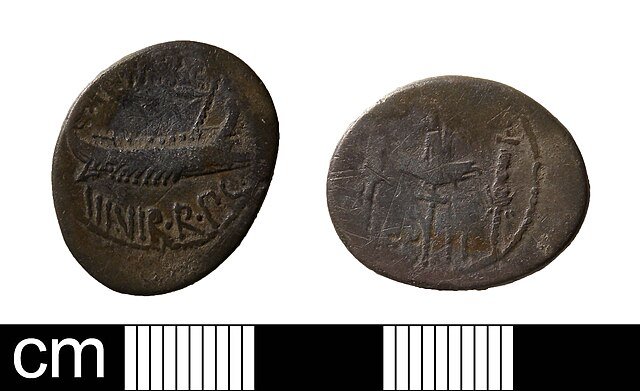Early Roman Republican Coins: From Bronze Lumps to Silver Strikes
How rough bronze turned into silver masterpieces—and what they tell us about the rise of early Roman Republican coins.
🪨 The Humble Beginnings: Aes Rude and Bartering Brains
Let’s rewind the clock to before Rome became Rome as we imagine it—before Caesars and empire-wide roads. Back then, people weren’t carrying wallets full of shiny coins. They used aes rude—just raw chunks of bronze. No inscriptions. No portraits. Just weight. You’d trade a hunk of it for a goat, a tool, or maybe a jug of wine.
There was no mint, no fancy designs—just trust and a scale. But Rome, being Rome, wasn’t going to stay primitive for long.
🧱 Big, Bold, and Bronze: The Arrival of Aes Grave
By the 3rd century BCE, the Romans decided it was time to formalize their economy. Enter the aes grave, or “heavy bronze.” These weren’t your pocket change. Some weighed over 300 grams—as big and chunky as hockey pucks.
Coins like the As (1 unit) featured the iconic Janus head on the front and a ship’s prow on the back—very on-brand for a rising naval power. Smaller denominations like the Semis, Quadrans, and Uncia followed, often showing gods like Saturn or Hercules.
💡 Tip for collectors: A good aes grave in nice condition is a treasure—hard to store, but impossible to ignore.
🏺 Greek Style, Roman Purpose: Silver Didrachms
As Rome started bumping shoulders (and swords) with the Greeks in southern Italy, their money took a sharp turn. They introduced silver didrachms around 269 BCE—clearly inspired by Greek coins. These were slimmer, shinier, and struck instead of cast.
The designs? Very Mediterranean: Mars, Victory, horse heads. You’d think it was minted in Syracuse or Neapolis, and you wouldn’t be wrong—they likely were.
📍 These coins were a clever move—Romans needed something Greek mercenaries and traders would actually trust. Bronze bricks just wouldn’t cut it anymore.
⚖️ The Big Shift: The Birth of the Denarius
Then came 211 BCE, smack in the middle of the Second Punic War. Rome needed to pay troops—fast and in a form people accepted across the region. That’s when the silver denarius was born.
It became Rome’s powerhouse coin for centuries.
🪙 Standard Denominations:
- Denarius (marked X = 10 asses)
- Quinarius (V = 5 asses)
- Sestertius (IIS = 2.5 asses)
The early denarius had Roma’s helmeted head on one side, and the Dioscuri (Castor and Pollux) riding horses on the other—symbols of protection and military might.
⚒️ These coins were struck, not cast. The detail was crisp, and the message was clear: Rome was organized, professional, and here to stay.
🏛️ Not Just Money—Miniature Billboards
Republican coins quickly evolved into tools for politics and self-promotion. By the 2nd century BCE, moneyers (those authorized to mint coins) started adding their names, family emblems, and even subtle campaign messages.
Here’s where things get fun:
- Some coins showed trophies, weapons, or temples, boasting of recent victories.
- Others honored ancestors or mythological roots—a subtle flex.
- And then there’s Brutus, who in 44 BCE minted the infamous “EID MAR” denarius after assassinating Caesar. Yes, it celebrated the murder—with daggers and all. That coin is pure drama in silver form.
📍 Where Were These Coins Made?
At first, it was mostly Rome, but as the Republic grew, mints popped up across Italy and even in war zones to pay troops.
Coins weren’t just for trade—they were how generals paid armies, won loyalty, and spread influence. It’s like printing your campaign posters on legal tender.
🔍 Notable Early Coins (And Why They Matter)
| Coin | Features | Date | Metal | Weight |
|---|---|---|---|---|
| Aes Grave As | Janus / Ship prow | ~280 BCE | Bronze | ~300g |
| Didrachm | Mars / Horse head | ~269 BCE | Silver | ~6.7g |
| Denarius | Roma / Dioscuri | ~211 BCE | Silver | ~4g |
| EID MAR Denarius | Brutus portrait / Dagger + Cap | 44 BCE | Silver | ~3.9g |
You can tell the story of Rome’s rise just by looking at how their coins changed. From weight-based trade to state-run propaganda tools—it’s all there in the metal.
🧠 Collector’s Take: Why These Coins Matter Today
These early Roman Republican coins don’t always get the love they deserve. Empire-era aurei with emperor portraits are flashy—but early coins? They’re the raw story of Rome becoming Rome.
- Aes grave pieces are rare, heavy, and incredibly satisfying to hold.
- Didrachms are a blend of Greek style and Roman ambition.
- Denarii offer consistent artistry and often sharp strikes, especially early issues.
- EID MAR? If you find one, guard it with your life (or sell it for millions).
🧭 Collecting tip: Always look for clear symbols, legends, and good provenance. Some of the best finds have come from Italian hoards, Sicilian fields, or old European collections.
🔗 Keep Exploring on NumisDon
- How Ancient Roman Coins Were Made
- Roman Coin Values Guide
- Denarius: Rome’s Silver Powerhouse
- Identifying Roman Bronze Coins
